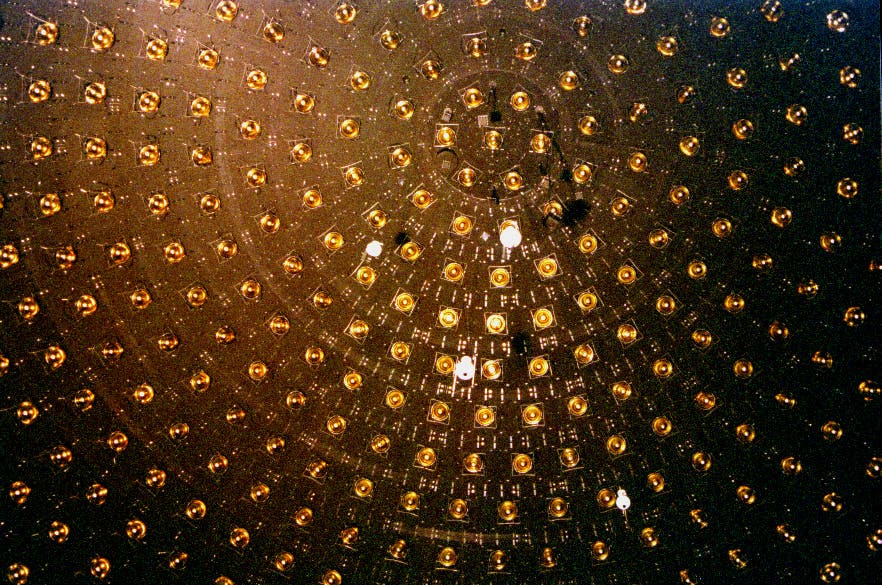Pulsars or dark matter? The Milky Way’s central glow just got more puzzling
New simulations by Johns Hopkins University suggest dark matter, not pulsars, may explain the Milky Way’s mysterious gamma-ray glow.

The Galactic Center Excess, shines in high-energy gamma rays that can’t be explained by ordinary astrophysical processes. Its origin has become one of the great cosmic riddles of modern science. (CREDIT: Shutterstock)
For over a decade, a dim but persistent glow near the center of the Milky Way has confused astronomers. This mysterious emission, known as the Galactic Center Excess, glows in high-energy gamma rays that cannot be accounted for using normal astrophysical processes. Its source has become one of the big cosmic riddles of the modern era—one that might ultimately lead humankind to demonstrate the existence of dark matter.
When the glow first appeared in 2009 to NASA's Fermi Gamma-ray Space Telescope, scientists had a pair of contrasting hypotheses. One proposed that the light was generated by particles of dark matter colliding and annihilating one another. The other suggested a throng of quickly spinning neutron stars known as millisecond pulsars, or MSPs, that are recognized to emit gamma rays as they spin hundreds of times per second.
New Simulations Reshape the Debate
A new study led by Moorits Mihkel Muru of the Leibniz Institute for Astrophysics Potsdam and carried out in collaboration with researchers from France, Germany, Israel, and the United States offers fresh perspective on this mystery.
Using sophisticated computer simulations facilitated by the Hestia Project, the researchers modeled how dark matter may actually be distributed across the Milky Way. Their work reveals that dark matter near the center of the galaxy is not spherically distributed, as earlier models had indicated, but flattened and box-like in agreement with the galaxy's old stellar bulge structure.
That shape is a strong tip-off. For decades, perhaps the strongest argument against dark matter was that the gamma-ray glow's boxy shape seemed to be more in line with pulsars. But if dark matter itself produces a similar flattened shape, that doesn't count anymore. The results mean the excess radiation can just as easily be explained by colliding dark matter particles as decaying stars.
“Our key new result is that dark matter fits the gamma-ray data at least as well as the rival neutron star hypothesis,” said cosmologist Joseph Silk of Johns Hopkins University and the Institut d’Astrophysique de Paris. “We’ve increased the odds that dark matter has been indirectly detected.”
The Physics Behind the Glow
Dark matter makes up about 27% of the universe, but it doesn't reflect, emit, or absorb any light. We know of it only through its gravitational force on galaxies and galaxy clusters. Everything that we can observe—planets, stars, and even tacos—makes up less than 5% of the cosmic cake. The rest is dark energy, the mysterious force driving the universe's expansion.
The favorite dark matter candidate is a theoretical particle known as the WIMP, or Weakly Interacting Massive Particle. WIMPs allegedly annihilate when they collide, releasing gamma rays in the process. If there is a dense cloud of these particles in the center of the Milky Way, collisions would produce just the kind of signal that Fermi-LAT detected—a bright glow thousands of light-years across.
But pulsars offer a glimmer of hope. These ancient neutron stars, spinning at dizzying speeds, also emit beams of gamma rays. With millions of them packed tightly in the galactic bulge, their combined light could mimic the dark matter annihilation signature. The catch is that it would take multiple orders of magnitude more pulsars than astronomers have observed to explain the signal.
A Galaxy Built by Collisions
The Hestia simulations added a key new ingredient to the equation: the Milky Way's violent history. Billions of years ago, the galaxy came together in a set of violent mergers with smaller dark matter–dominated systems. Those first collisions left behind a warped and flattened core—a setup that could naturally control the distribution of dark matter today.
By factoring in this merger history, the researchers produced simulated gamma-ray maps that looked strikingly similar to real data from the Fermi telescope. The match strengthens the idea that dark matter, rather than pulsars, could be responsible for the glow. Still, as Silk emphasized, “Gamma rays, and specifically the excess light we’re observing at the center of our galaxy, could be our first clue.”
The Case for and Against Each Theory
Both theories capture the seen gamma-ray spectrum from one to ten giga-electron volts (GeV), but they are different at higher energies. WIMP annihilation would cause a steep decline in emissions around half the particle's mass—around 50 GeV—while pulsars would have a more gradual loss reaching almost a trillion electron volts (1 TeV). Seeing that difference might finally confirm which theory is right.
And yet, even the pulsar model is beginning to come under attack. Scientists would have to hypothesize an vast population of dark, faint pulsars in the galactic bulge to explain its luminosity. Only one-tenth of the gamma-ray excess that has been seen can be explained by the known populations of pulsars. Unless many more unseen pulsars are found, the dark matter argument becomes more compelling by the day.
On the other hand, decades of direct Earth-based searches for dark matter have produced nothing. Underground detectors are still sensitive but have yet to detect a single dark matter particle. As experiments approach the so-called "neutrino floor" where background neutrinos dominate potential signals, astrophysical observations like the Galactic Center Excess will be the last hope for the detection of indirect signals.
The Next Generation of Observatories
The next big step towards cracking this cosmic mystery will be from the Cherenkov Telescope Array Observatory (CTAO) now under construction in Chile. It will be the world's most powerful ground-based gamma-ray telescope when completed, capable of detecting signals as high as and beyond the TeV range. Scientists believe it will sort out the dark matter versus pulsar hypotheses by recording the high-energy "tail" of the gamma-ray spectrum.
A second project, the Southern Wide-field Gamma-ray Observatory, will complement CTAO by surveying huge regions of the sky. They'll both investigate not only the Milky Way, but also tiny, close-by dwarf galaxies—dark regions where dark matter would be conspicuous against fainter backgrounds.
Astrophysicists believe that if next-generation devices record a cut-off of sharp energy, that would be a "smoking gun" for dark matter annihilation. And if they record instead a power-law tail such as is found associated with pulsars, the mystery would be why so many of them were created and survived in the galactic center.
Practical Implications of the Research
If confirmed, this research would be the first tangible evidence of dark matter—reshaping physics, cosmology, and even the process of galaxy formation.
Comprehend how dark clumps of matter may account for the reasons galaxies like the Milky Way look like they do, and why their stars move as they do. It could also dictate the search for new physics outside the Standard Model, perhaps illuminating the path towards supersymmetric particles or hidden forces.
To mere mortals, it would offer a solution to one of mankind's oldest riddles: what the universe actually consists of.
Research findings are available online in the journal Physical Review Letters.
Related Stories
- Dark matter may end our universe in a 'Big Crunch'
- Dark matter and dark energy may not exist, new research finds
- Dark matter particles may live longer than the universe itself, study finds
Like these kind of feel good stories? Get The Brighter Side of News' newsletter.
Joseph Shavit
Science News Writer, Editor-At-Large and Publisher
Joseph Shavit, based in Los Angeles, is a seasoned science journalist, editor and co-founder of The Brighter Side of News, where he transforms complex discoveries into clear, engaging stories for general readers. With experience at major media groups like Times Mirror and Tribune, he writes with both authority and curiosity. His work spans astronomy, physics, quantum mechanics, climate change, artificial intelligence, health, and medicine. Known for linking breakthroughs to real-world markets, he highlights how research transitions into products and industries that shape daily life.



